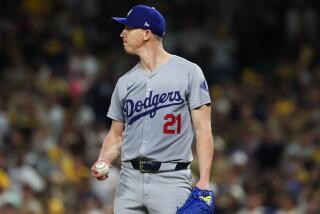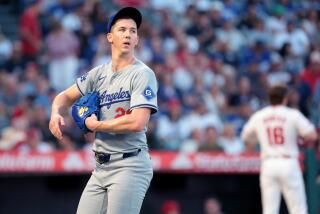He’s Been in There Pitching for the Dodgers for 25 Years
Name the only currently active pitcher to have taken the mound for the Dodgers every year for the last quarter-century.
Need a hint? He’s also had more of his pitches knocked out of the park than any other hurler in Dodger Stadium history, yet is proud of it.
The answer? Mike McDermott.
Mike who?
He’s the Dodgers’ longtime batting practice pitcher, a self-effacing Sierra Madre resident who works days for the transportation division of the Los Angeles Unified School District. Since 1969, the mustachioed McDermott has hurled more than 100 pregame pitches about 80 times a year--with consistency, pride and just enough zip to satisfy an ever-changing lineup of all-stars and also-rans.
The pay is little more than beer and hot-dog money at many major league ballparks. But the benefits are outstanding.
Besides hanging out with the team, McDermott savors firsthand memories of the legendary duel between reliever Bob Welch and slugger Reggie Jackson during the 1978 World Series, the hobbled Kirk Gibson’s dramatic ninth-inning homer in the 1988 Series, and Pope John Paul II’s unprecedented “sermon toward the mound” from a 14,000-square-foot stage in center field in 1987.
“As a matter of fact, this is no big deal, but you know the chair the Pope sat in, he had that big, tall white chair?” McDermott, 43, recalls with a smile. “I sat in it.
“I don’t know, (maybe) I hoped it would rub off or something.”
*
The compact, curly haired McDermott began his career with the Dodgers at 17 in 1967, unpacking uniforms in the visiting team’s dugout.
As a youngster growing up in Alhambra, he had developed a decent fastball and slider, and he pitched college ball at Pasadena City and Cal State L.A.
His arm was not of major league quality, but McDermott was blessed with pinpoint control and had an excellent attitude, which led to his being offered a tryout in batting practice pitching.
McDermott, known as “Mac” to the players, has rarely looked back.
Over four decades, he has thrown to many of the biggest names in Dodger history, and for several years he accompanied the team on road trips. During his marathon stint, McDermott has missed only a handful of home games, the result of an eye infection and a sore arm.
“He throws good strikes, he puts the ball over the plate and he’s dependable,” said McDermott’s 17-year boss, bullpen coach Mark Cresse. “You don’t have to worry about him showing up. He takes the job seriously.”
McDermott is also thick-skinned, a necessary attribute for anyone who has hung around a professional baseball clubhouse for 25 years.
“You know the team is going bad when they’re doing a story on Mac,” jibed coach Ron Roenicke while leaning against the batting cage the other day. “Really bad,” echoed pitching star Orel Hershiser.
McDermott takes the banter in good humor.
“Someone gives you a hard time, I tell them: ‘I was pitching batting practice while you were in second grade. So don’t give me any. . . .’
“I’ve got four championship rings. Not many batting practice pitchers can say that.”
On a typical workday, McDermott, one of four non-playing Dodger batting practice pitchers (the coaches and Manager Tom Lasorda also do some pregame hurling), arrives at Dodger Stadium more than three hours before game time.
Entering through the center field gate, the 5-foot-9 hurler strides across the sunshine-soaked, emerald-green field to the Dodger dugout, disappearing down a corridor into a Spartan dressing room. It’s a few hundred feet--and a $1 million or more annually in salary--from the team clubhouse.
There, he changes into his uniform (No. 67) while Dodger pitchers Jim Gott and Kevin Gross, dressed in black uniforms instead of their more customary white ones, practice martial arts a few feet away.
During his prime, McDermott threw batting practice to the Dodger starting lineup. These days, his arm having lost a little power, he throws to the team’s pitchers, who despite their meager batting averages and relatively rare game appearances at the plate take batting practice extremely seriously.
The role of a batting practice pitcher is opposite that of most pitchers. McDermott cannot try to strike out any batters. A showboat would last closer to 25 minutes than 25 years.
So standing behind a protective screen, with an extra ball tucked in his glove, McDermott lays it over the plate time and again with machine-like precision.
In 15 minutes, beginning precisely at 4:55 p.m., the Dodger pitchers, who look and act like skittish racehorses as they stand around the batting cage, knock five pitches out of the park and refuse to swing at only five balls deemed to be outside the strike zone.
Afterward, McDermott trots to the outfield, shagging flies and bantering with Dodger players until 6:10 p.m. Then he showers and heads for the field-level box seats behind home plate.
It is there that he vies for the title of Los Angeles’ ultimate sports fan. Despite his access to such an exclusive viewing perch, McDermott generally splits by the third inning.
“If it’s a big game, I’ll hang,” he said. “But you see a lot of games.”
*
Major league baseball isn’t what it used to be during the Dodgers’ glory years of the 1970s and 1980s, McDermott says. In an era of staggering salaries and players switching teams like commuters switching freeways, the communal feeling just isn’t there.
Nevertheless, as his 25th season comes to an end, McDermott still loves his part-time post and hopes to continue as long as his right arm stays strong.
Occasionally, he says, he feels as if he will not make it through another practice. But more frequently, his $48-a-day arm still feels like a million bucks.
“If my arm feels like it did the last couple days,” McDermott said with gusto last week, “I’ll last a couple more years.
“I used to sit in that top deck when I was a kid,” he continued, pointing toward the heavens behind home plate, “thinking of how to sneak down some day and touch the grass.
“Little did I know. . . .”
More to Read
Are you a true-blue fan?
Get our Dodgers Dugout newsletter for insights, news and much more.
You may occasionally receive promotional content from the Los Angeles Times.







